Bellin College, MCW-Green Bay take part in disaster simulation
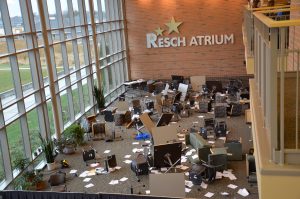 The Bellin College Atrium and Health Sciences Resource Center of Bellin College was transformed Thursday, April 18, 2019, into a simulated multi-casualty tornado event. The simulation aimed to give students at Bellin College and the Medical College of Wisconsin-Green Bay a chance to practice skills learned in the classroom and at various clinical sites.
The Bellin College Atrium and Health Sciences Resource Center of Bellin College was transformed Thursday, April 18, 2019, into a simulated multi-casualty tornado event. The simulation aimed to give students at Bellin College and the Medical College of Wisconsin-Green Bay a chance to practice skills learned in the classroom and at various clinical sites.
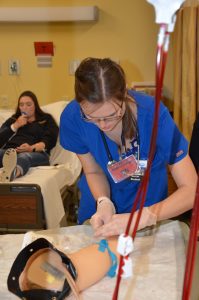 The event is the culmination of multiple departments working together for the past 4-5 months to give students the real-world experience in a controlled environment. Students in the nursing, radiologic sciences and sonography programs and M2 students with Medical College of Wisconsin-Green Bay took part in the event.
The event is the culmination of multiple departments working together for the past 4-5 months to give students the real-world experience in a controlled environment. Students in the nursing, radiologic sciences and sonography programs and M2 students with Medical College of Wisconsin-Green Bay took part in the event.
“This simulation allows students the opportunity to not prepare for the simulation like they have in the past and to have to come in and not know what role they will have, what kind of patients they will work with and what will need to be done,” said Kathie DeMuth, assistant professor of nursing for Bellin College.
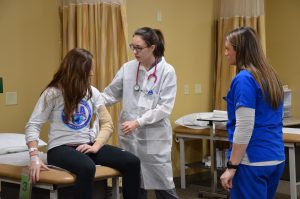 Staff volunteers and students were staged in the Atrium area to recreate all aspects associated with a multi-casualty event. In total, there were 42 “patients” for students to contend with and prioritize, as they would if it were a real-life scenario. These simulated patients also received realistic-looking makeup, or moulage, to increase the legitimacy of his or her injuries.
Staff volunteers and students were staged in the Atrium area to recreate all aspects associated with a multi-casualty event. In total, there were 42 “patients” for students to contend with and prioritize, as they would if it were a real-life scenario. These simulated patients also received realistic-looking makeup, or moulage, to increase the legitimacy of his or her injuries.
“Disasters are increasing at local, national, and global levels, as is the need for all nurses and communities to be prepared,” said Kevin Stringer, HSRC technology specialist. “Today’s graduating nurses need strong skills in disaster nursing to manage a variety of disasters in a local to a global context. Nurses can bring unique skill sets to manage emergency situations, including proper assessment, priority recognition, communication, and collaboration skills. Competency in these skills allows nurses to make accurate, life-altering decisions in highly emergent and demanding situations. This realistic, hands-on activity approach allows them to experience a disaster before job placement.”
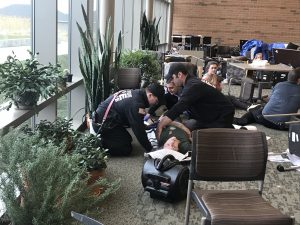 Students were joined by various healthcare professionals from the area along with the Bellevue Fire and Rescue Department and County Rescue Services. Eight doctors and several nurses were on campus to help guide students in their simulation.
Students were joined by various healthcare professionals from the area along with the Bellevue Fire and Rescue Department and County Rescue Services. Eight doctors and several nurses were on campus to help guide students in their simulation.
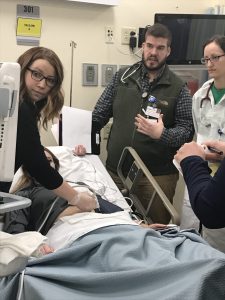
Dr. Brad Burmeister
“The disaster drill is really an exciting event for all of the students,” said Dr. Brad Burmeister, clinical professor with Medical College of Wisconsin-Green Bay and Bellin Health doctor. “This is my second year involved as a faculty member at the Medical College of Wisconsin – Green Bay campus. While the opportunity to hone some clinical skills is certainly present for the disaster, the biggest asset and unique opportunity are to work with other students.
“Oftentimes interprofessional collaboration is difficult to emulate for a student — they often are working and learning sort of independently in the clinic, ER, or in the OR,” he said. “Putting them in charge of a disaster though forces them to work together and communicate. While our group did great with communication, we had a good conversation at the debriefing about how communication could be better in the future.”
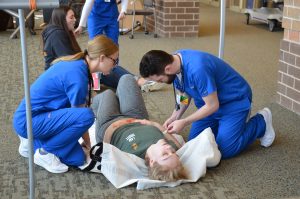
Sonography and radiology students also assisted with the simulation drill. The different departments often don’t get a chance to work together, but got their chance during the event.
“Imaging students have worked with the nurses in different aspects before, but not in a disaster situation. We have these objectives for all students. Interprofessional communication is key,” said Christina Smith, radiologic sciences instructor.
The main objectives for participating students are:
- Appreciate the importance of interprofessional communication
- Demonstrate effective use of knowledge, skills and abilities to safely provide patient care
- Collaboratively and implement interventions based on assessments and priorities
- Identify value of partnerships in provision of quality patient care
Staff usually conducts two simulation events per year — in spring and fall. They can range from a shooting incident, fire and anything in between.

